#isabella of castile
Photo

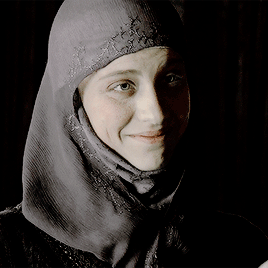
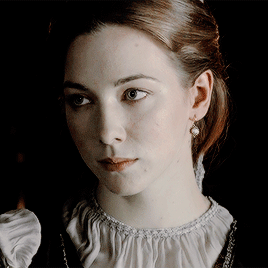

3 December 1497: Elizabeth of York, Queen of England, writes a letter to Isabella, Queen of Castile, asking after her future daughter-in-law’s health.
‘Hence it is that, amongst our other cares and cogitations, first and foremost we wish and desire from our heart that we may often and speedily hear of the health and safety of your serenity, and of the health and safety of the aforesaid most illustrious Lady Catherine our common daughter. And if there by anything in our power which would be grateful or pleasant to your majesty, use us and ours as freely as you would have all in common with you. We should have written you the news of our state, and written at length of these things to your majesties. For the rest may your majesty fare most happily according to your wishes.
From our palace of Westminster, 3rd day of December, 1497’.
Complete transcript of Elizabeth’s letter (x).
#historyedit#history#elizabeth of york#catherine of aragon#isabella of castile#the tudors#henry vii#henry viii#perioddramaedit#tudoredit#tudorsedit#the six wives#**
208 notes
·
View notes
Text

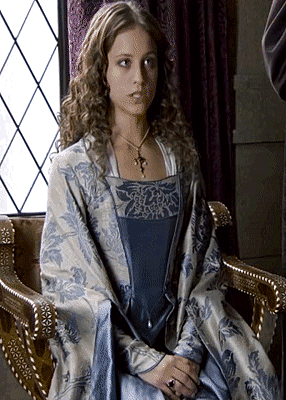

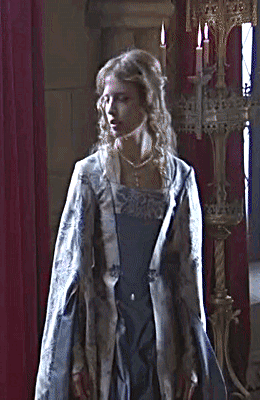


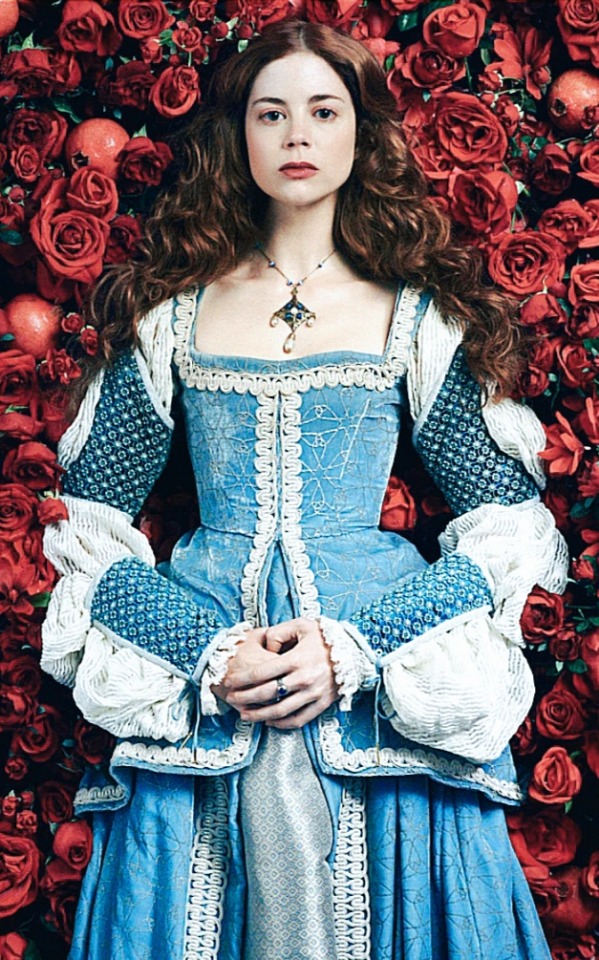
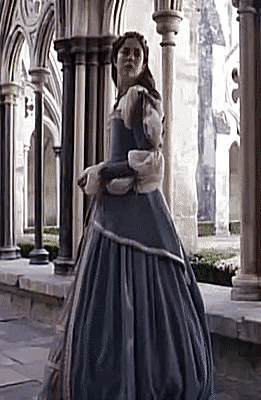
Isabel of Castile and Katherine of Aragon in blue
Michelle Jenner in "Isabel"
Charlotte Hope in "The Spanish Princess"
#catherine of aragon#katherine of aragon#catalina de aragon#isabel de castilla#isabella of castile#michelle jenner#charlotte hope#isabel tve#the spanish princess
68 notes
·
View notes
Text

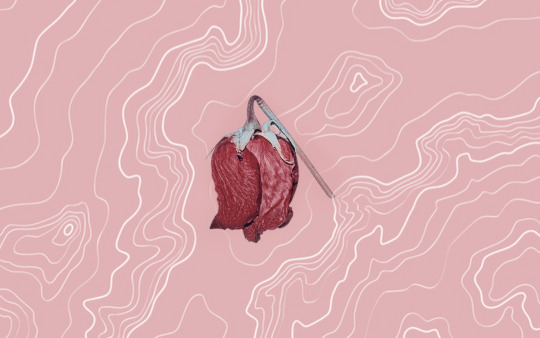


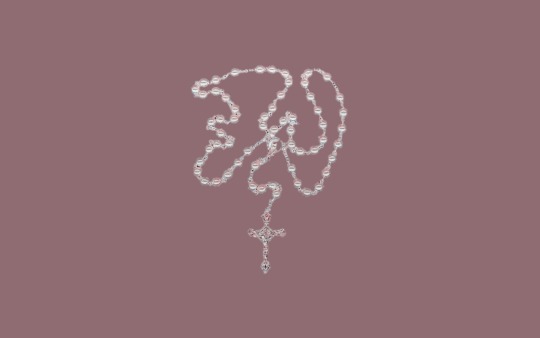



Isabel and Juana of Castile + quote
Happy birthday @latristereina !
Isabel had good cause for being upset. Such was “the disposition of the Princess” as the physicians described it, “that not only should it pain those who see her often and love her greatly, but also anyone at all, even strangers, because she sleeps badly, eats little and at times nothing, and she is very sad and thin. Sometimes she does not wish to talk and appears as though in a trance; her infirmity progresses greatly.” It was customary, they explained, to treat Juana’s infirmity through love, entreaty, or fear; but the princess had proven unreceptive to entreaty, and even “a little force” affected her so adversely that it was a great pity to attempt it and no one wanted to try, so that, beyond the queen’s customary immense labors and concerns, this weight of caring for her daughter fell upon her. It has been conjectured that Isabel’s illness could have been cancer, endocarditis—infection of the heart valve—chronic dropsy, or several of them combined. By the following June she had a visible tumor, although it is not known where or of what sort. In August she took Juana to Segovia, which she had seemingly avoided for years, telling her it was a step toward the north coast and her departure for Flanders. There Isabel continued to try with little success to get her to turn her mind to affairs of state.
Juana showed little interest in government and in her child, and a good deal of disregard for religious matters of any sort, and for public opinion as well. The princess appeared to disdain much of what Isabel valued, and even to represent the antithesis of the very qualities her mother valued most highly. Even so, Juana was her designated successor, and Isabel was determined to keep her in Spain and do her best to train her to be its queen. So the arguments against Juana’s departure were patiently repeated: the season, the sea, the French, that Philip should be safe in Ghent before she traveled, and did she not want to see her father before she left? The hope remained that Juana would stay and Charles join her, so that Isabel might have him educated in Spain’s customs and come to prefer its people. And with Juana and Charles there and Philip not, should Isabel die, Fernando, still king of Aragón, could surely manage to guide their daughter in governing Castile.
It was November. A treaty with France—arranged by the queen of France, Anne of Brittany, and Margaret of Austria—had been signed, and an envoy arrived from Philip requesting that Juana return to Flanders. Isabel, playing for time, responded that the princess, although better, was not well, that relations with France were still such that it was not safe for her to travel by land or, now that it was winter, by sea, that she had better wait until spring, and that “following her frame of mind and la pasión she has” that Juana should not be where there was no one who could quiet and restrain her for it might be dangerous for her. The implication was that Juana was emotionally out of control. Exactly what was meant by “restrain” we do not know.
-Peggy K. Liss, Isabel the Queen
#isabel de castilla#isabella of castile#juana de castilla#joanna of castile#joanna i#Isabel tve#juana la loca#mad love#michelle jenner#pilar lopez de ayala#period drama#perioddramaedit#historical women#my edits#graphic edit#filter by crownedfilters on ig
102 notes
·
View notes
Text


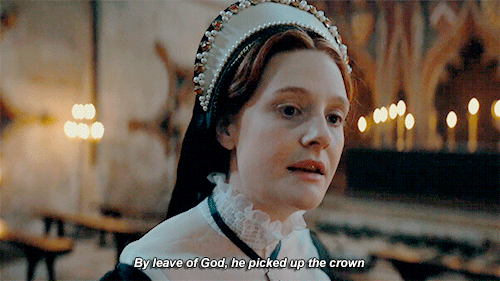

The boldness and scale of her achievement are often overlooked. The campaign that Mary led in the summer of 1553 would prove to be the only successful revolt against central government in sixteenth-century England. She, like her grandfather Henry VII and grandmother Isabella of Castile, had to fight for her throne. In the moment of crisis she proved decisive, courageous, and “Herculean”—and won the support of the English people as the legitimate Tudor heir. (X)
#mary i#henry vii#becoming elizabeth#perioddramaedit#historyedit#mine: perioddrama#mine: history#mine: gifs#mine.#rayedit.#mary tudor#henry tudor#isabella of castile#tudor history#becomingeelizabethedit#perioddrama#historicaldrama#romola garai#tudor england#i likes this scene
806 notes
·
View notes
Text
Random saints by Sittow or Catherine of Aragon's parents?

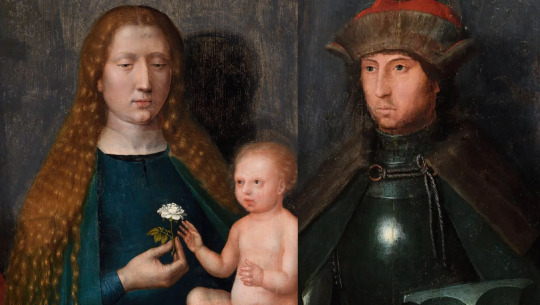
Read further if you wish to know what my theory is.
I first found this photo with mention it is by Sittow and at first I thought it is another portrait of Catherine. But quickly I realised this woman looks older and the features are not exactly the same.
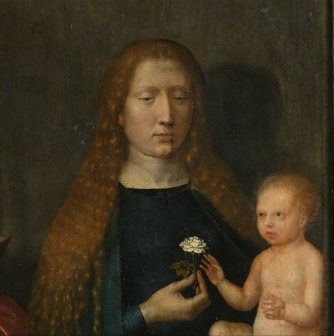
The nose is much narrower. And I started to wonder...we know that Sittow painted at least one portrait of Queen Isabella I of Castile.
And she had such nose. I could exclude possibility some of Catherine's sisters looked like this too, but women in that family tended to be very young-looking for really long.
So the age of sitter already is suggesting that it could be based upon Isabella towards end of her life. And it is also odd for depiction of Virgin Mary to depict woman who is not young...it is point in Isabella's favour.
While many claim Sittow painted Isabella in 1485, he was only born in 1468/1469 and didn't even become indipended master until at least 1488. He is first recorded working in Toledo in 1492. So he'd always be only able to depict Isabella over age of 40. And tbh, if this is her..then she looks great for somebody over 40!
But where is this image? It took me while to track down.
It's detail from wings of theThe Passion Altarpiece (Tallinn), its middle part is from c.1515-1520(with some 17th century additions) by different artist.

But I am not so sure how accurate is the dating of the outer wings by Sittow(1518-1525) which are in very different style, and might have originally belong to different altar middle.

If it is indeed 1518-1525 dating, then imo they are posthumous depictions based upon earlier sketches done from life. Sittow reusing those old sketches, using them as inspiration for his later work.
Link to photos only. Left pannel: https://artsandculture.google.com/asset/the-passion-altarpiece-outer-wing-with-the-virgin-mary-and-apostle-james-the-greater-paintings-of-the-outer-side-of-the-wings-by-michel-sittow-and-his-workshop/BwFnRG1v6gRqmQ
Right pannel: https://arthive.com/artists/75951~Michel_Sittow/works/526786~Saint_Adrian_and_Saint_Anthony
As to where they are located?
-Niguliste Museum(housed in former St. Nicholas' Church), which is part of Art Museum of Estonia(which combines collections from 3 other buildings+ this church). Hence in Tallin, Estonia but be aware there is over 3 km distance in between the church and other buildings.
But if anybody could go there and get us some pictures it'd be great (if it is allowed). Currently Niguliste Museum has exhibition about Sittow:

But back to the pannels. The left one depicts Madonna(Virgin Mary holding baby Jesus) and St. James the Great(apostle and patron saint of Spain:
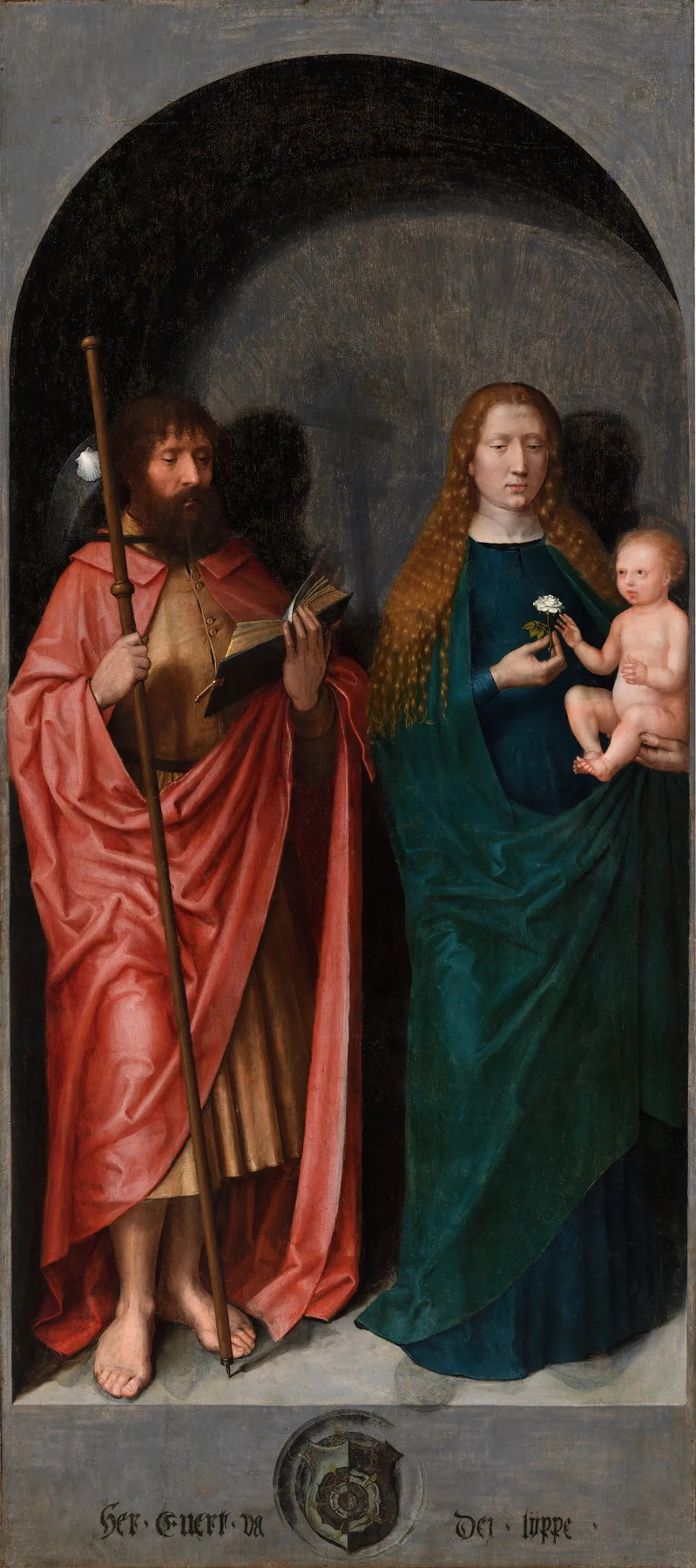
And please note that Tudor rose is combination of red and white rose and not always it was depicted as inner rose white, outer red. Sometimes they were halfed, with inner rose sometiems also switched.

Of course it could be some foreign coat of arms or later alteration.
Right pannel:

Here the coat of arms looks much newer and is probably altered(and if pomegranate turned out to be beneath it, I'd just die...)
The right pannel is depicting two male saints. On right is St Anthony the Great...was father of monasticism(of monastic life)...thus very important saint in christianity...
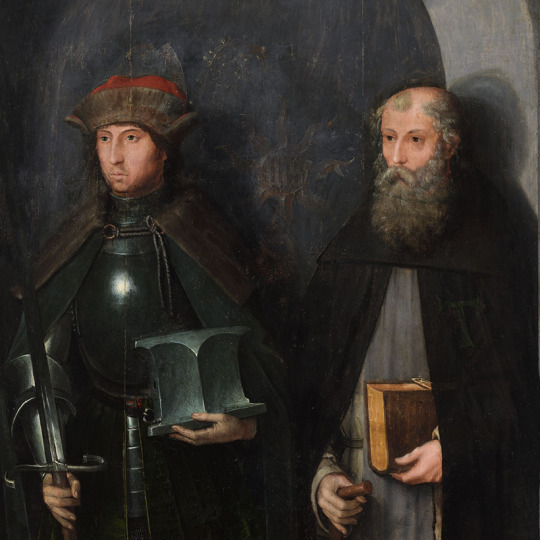
and on left St. Adrian of Nicomedia(2nd most popular military saint after St. George), and imo that's probably King Ferdinand II of Aragon:

It's not great likeness(brows not arched enough, looks bit slimmer, alla of nose not as defined), but overall it's enough of resemblence to not be able to exclude the possibility.
But if this is indeed done years after Sittow was in Spain...and he is reusing his old sketches of catholic monarchs to create this new religious scene(perhaps initially intended for them too, but never made into finished work before), then it is also possible that sketch done in pencil has partially rubbed off...and thus the differences in face of this male.
I think that if this was done while in Spain, such big differences are not very likely to occur. Not that pencil could not rub off, but I think Sittow would have noticed and cared about getting absolutely righ(to please his patrons) and thus would have corrected it.
Ehm, this kitty is supposed to be a lion:
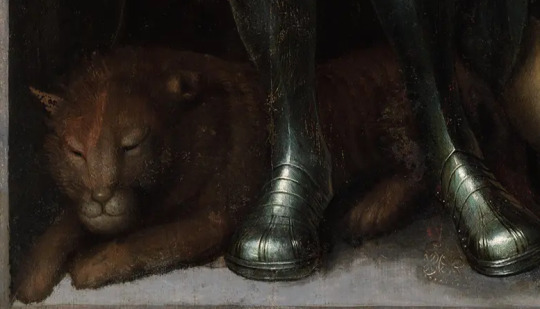
But you must be wondering, if Isabella indeed had this most vivid golden hair colour I always go on and on about, why does she have red hair here?
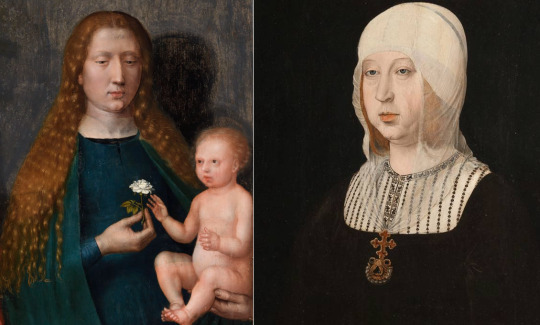
Several options to pick from: Pigments going wrong, Isabella's hair possibly turning to more reddish hues towards end of her life, or simply discoloured pinkish varnish which was very oddly applied...and on baby's skin you can see where somebody applied only one layer and where they went with brush for 2nd time.
If entire pannel has this varnish on, then it'd affect the hair, turning it more red. Why would such varnish not be removed? Sometimes money is tight and museums have multiple paintings to care for and those paintings in fairly good condition have to wait longer.
And sometimes it is not possible to remove discoloured varnish without harming the painting beneath.
Also worth of nothing is that Virgin Mary's dress is typically not teal, but vividly blue, the very best most expensive most vivid blue pigments were very often reserved for depicting the Virgin Mary:

Sometimes due to budget cost cheaper substitues were used, and those tend to fade.
Hence imo the colours originally might have been intended to be more like this(yes, I photoshopped it):

(I didn't change damn thing about male figure, just brightened it. But tbh I played with the woman's dress, skin and hair for while.)
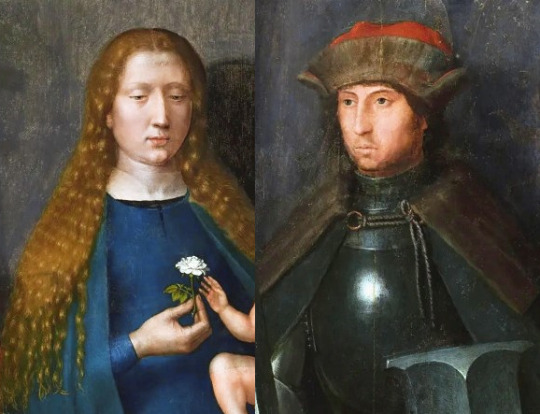
I mean if it looked like this now, fans of catholic monarchs would probably be all over it already.
But people overlook these dark slightly pinkish images located all the way in Estonia, even though it is atributed to Sittow himself!
(I don't mean people in Estonia, I mean people who search for Isabella's lost portrait by Sittow and stubbornly stuck to their favourite which is not even by Sittow!)

I honestly thought that people searching for lost portrait of Isabella by Sittow would have by now checked all his work, to see if perhaps she is there somewhere! Just doesn't look teen or young adult.
So I want you to be aware, if you're on quest of finding Isabella by Sittow's in that portrait with emerald necklace that this is imo the face you're looking for :

Possibly with hair bit more golden and skin more fair:
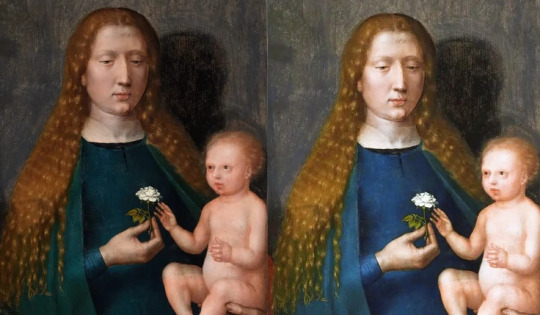
And it doesn't matter she doesn't look 20! She is still very beautiful.
Hence imo, these are Catherine of Aragon's parents, depicted in disguise of saints:

But I think they were likely painted years after Sittow left Spain, and his old sketches of them have been reused to create these pannels. I hope the experts will one day look more into this possibility.
I hope you've enjoyed this, and tell me what you think. Am I onto something or am I chasing shadows?


#historical portraits#isabella of castile#ferdinand of aragon#Isabella I of Castile#Ferdinand II of Aragon#sittow
69 notes
·
View notes
Text

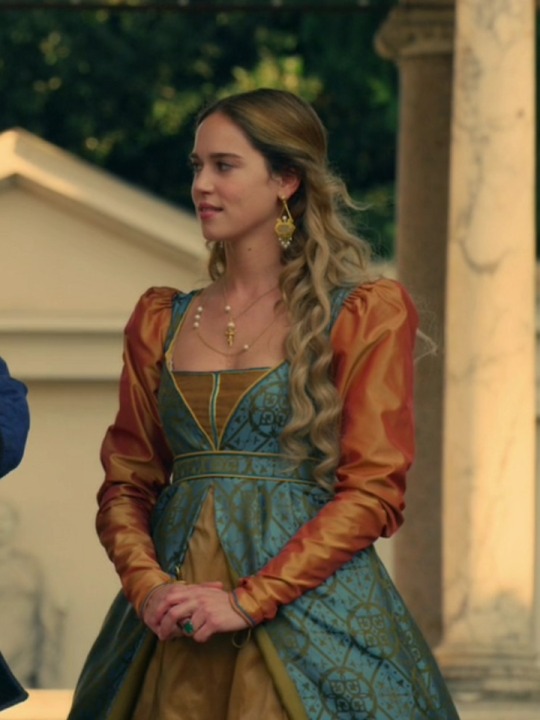
Period dramas dresses tournament: Orange dresses Round 1- Group C: Isabel de Castilla, El ministerio del tiempo (gifset) vs Simonetta Vespucci, Medici: the magnificent (gifset)
Propaganda for Isabel's dress:
Another pic 🧡🧡🧡

#period drama dresses tournament#tournament poll#tumblr tournament#polls#fashion poll#isabel de castilla#isabel la católica#isabella of castile#el ministerio del tiempo#simonetta vespucci#i medici#medici: the magnificent#medici the magnificent#orange r1#the ministry of time
18 notes
·
View notes
Text

10 notes
·
View notes
Text
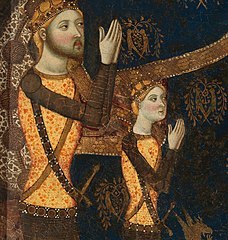

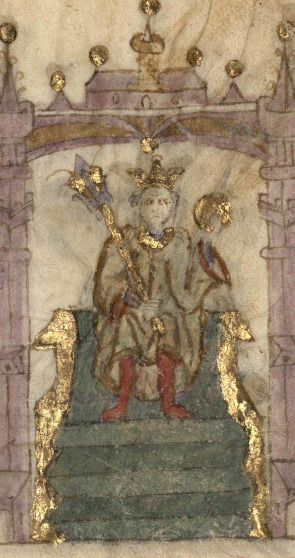
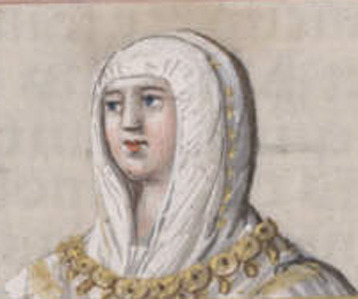
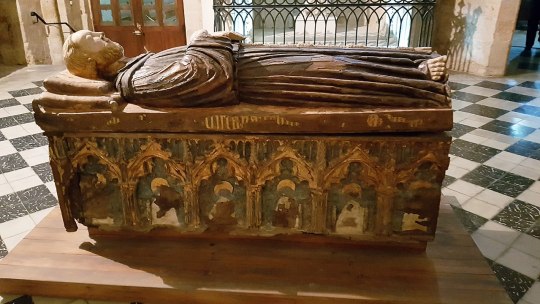
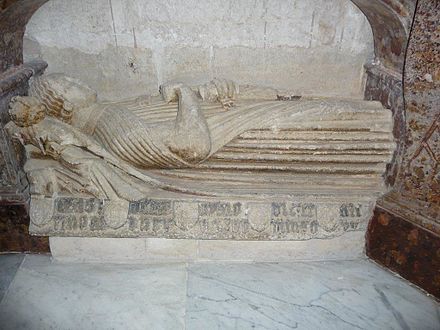

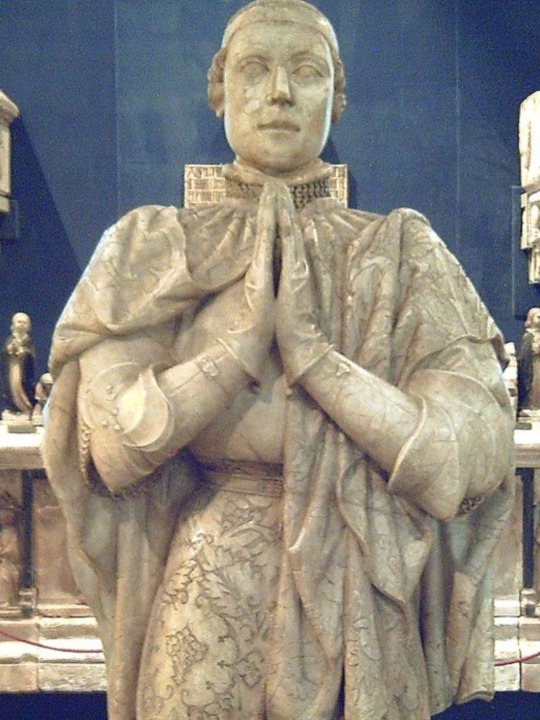
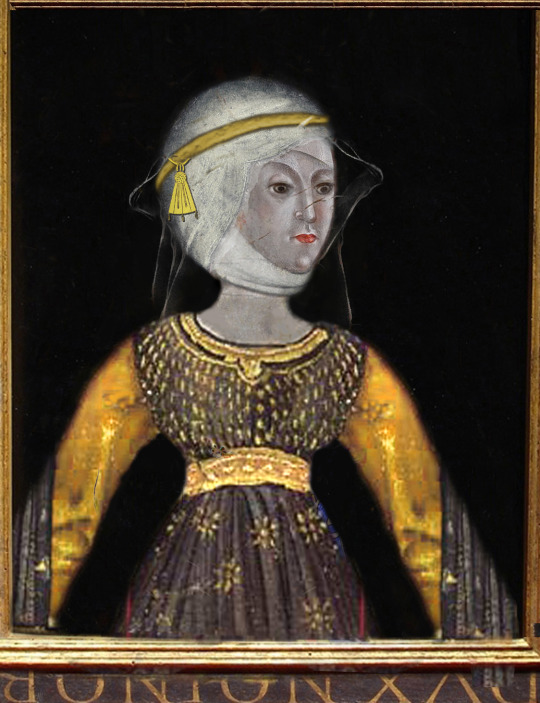

The Bastard Kings and their families
This is series of posts are complementary to this historical parallels post from the JON SNOW FORTNIGHT EVENT, and it's purpouse to discover the lives of medieval bastard kings, and the following posts are meant to collect portraits of those kings and their close relatives.
In many cases it's difficult to find contemporary art of their period, so some of the portrayals are subsequent.
1) Henry II of Castile ( 1334 – 1379), son of Alfonso XI of Castile and Leonor de Guzmán; and his son with Juana Manuel de Villena, John I of Castile (1358 – 1390)
2) His wife, Juana Manuel de Villena (1339 – 1381), daughter of Juan Manuel de Villena and his wife Blanca de la Cerda y Lara; with their daughter, Eleanor of Castile (1363 – 1415/1416)
3) His father, Alfonso XI of Castile (1311 – 1350), son of Ferdinand IV of Castile and his wife Constance of Portugal
4) His mother, Leonor de Guzmán y Ponce de León (1310–1351), daughter of Pedro Núñez de Guzmán and his wife Beatriz Ponce de León
5) His brother, Tello Alfonso of Castile (1337–1370), son of Alfonso XI of Castile and Leonor de Guzmán
6) His brother, Sancho Alfonso of Castile (1343–1375), son of Alfonso XI of Castile and Leonor de Guzmán
7) Daughters in law:
I. Eleonor of Aragon (20 February 1358 – 13 August 1382), daughter of Peter IV of Aragon and his wife Eleanor of Sicily; John I of Castile's first wife
II. Beatrice of Portugal (1373 – c. 1420) daughter of Ferdinand I of Portugal and his wife Leonor Teles de Meneses; John I of Castile's second wife
Son in law:
III. Charles III of Navarre (1361 –1425), son of Charles II of Navarre and Joan of Valois; Eleanor of Castile's huband
8) His brother, Peter I of Castile (1334 – 1369), son of Alfonso XI of Castile and Mary of Portugal
9) His niece, Isabella of Castile (1355 – 1392), daughter of Peter I of Castile and María de Padilla
10) His niece, Constance of Castile (1354 – 1394), daughter of Peter I of Castile and María de Padilla
#jonsnowfortnightevent2023#henry ii of castile#john i of castile#juana manuel de villena#eleanor of castile#alfonso xi of castile#leonor de guzmán#tello alfonso of castile#sancho alfonso of castile#peter i of castile#constance of castile#isabella of castile#asoiaf#a song of ice and fire#day 10#echoes of the past#historical parallels#medieval bastard kings#bastard kings and their families#eleanor of aragon#beatrice of portugal#charles iii of navarre#canonjonsnow
14 notes
·
View notes
Photo
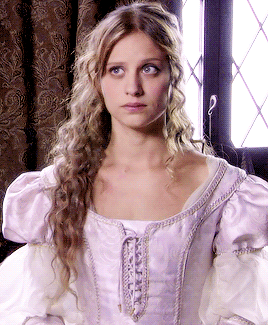

Isabel 1x02
53 notes
·
View notes
Text

Maribel Martín as Isabel I de Castilla in "La Espada Negra" (1976)
21 notes
·
View notes
Text
Say hi to the new wallpaper for my laptop!

-The quote does not belong to me, I saw it on Instagram and just wanted to create something interesting
credit: @lookbackwithliv -
#mood#happy#tumblr#follow#art#artists on tumblr#artist support#illustration#wallpaper#eleanor#jeanne la flamme#empress matilda#isabella of france#livia drusilla#gwenllian#gwenllian ferch gruffydd#anne of brittany#kali#isabella of castile#eleanor of aquitaine#history podcast#history#culture#history lesson#history memes#patriarchy#feminisim
5 notes
·
View notes
Photo


Ramon Madaula as Don Gonzalo Chacón in Isabel.
I’m only three episodes into this series (and a decade late) and I love him, I love him, I love him, Your Honor.
#drumming on pots: found myself a new times' man#I'm not even bothering with the tags tho#isabel tve#isabella of castile#content that caters to myself#i guess#spanish tv#15th century
16 notes
·
View notes
Text

Image labeled “A Very Early Portrait of Catherine of Aragon” by English School. For sale by Sloane Street Auctions. This is all the information I can find on this painting.
#catherine of aragon#katherine of aragon#katharine of aragon#catalina de aragon#the spanish princess#the tudors#tudor history#english history#tudor era#the six wives of henry viii#henry viii#king henry viii#henry tudor#isabella of castile#mary i#mary i of england#mary tudor#the tudor period#the tudor era#the tudor dynasty#tudor portraits#tudor period#tudor dynasty#tudors#tudor#spanish history#art#renaissance#renaissance art
126 notes
·
View notes
Text
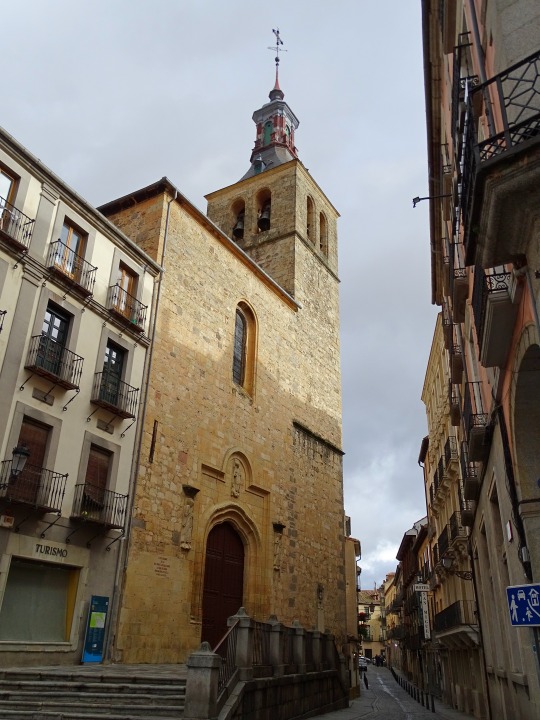

San Miguel de Segovia, the church where Queen Isabella I was crowned queen of Castile.
Segovia, Spain
Explore:
#segovia#spain#españa#architecture#travel#urbanexploration#photographers on tumblr#original photography#lensblr#photography#wandering#church architecture#isabella of castile#history#wanderingjana
5 notes
·
View notes
Text
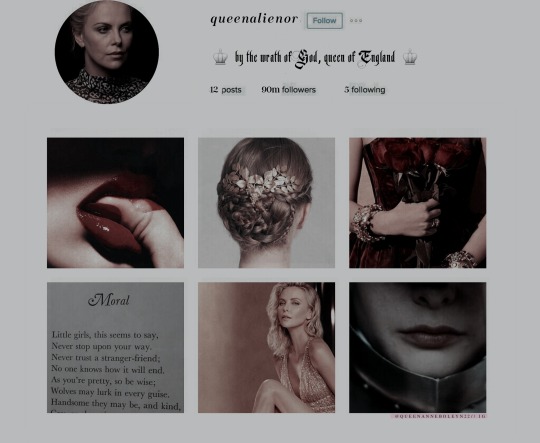



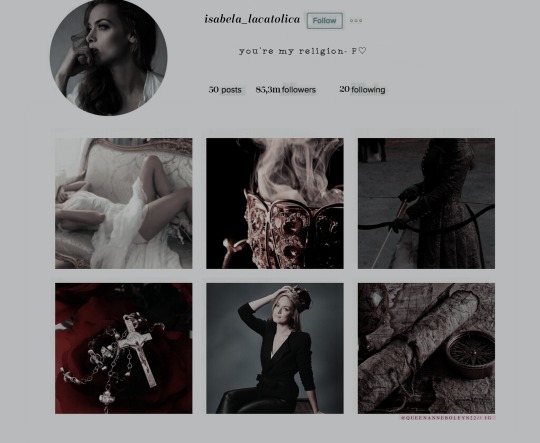

↳ #qab22modern
"I can barely conceive of a type of beauty in which there is no Melancholy. We are weighed down, every moment, by the conception and the sensation of Time. And there are but two means of escaping and forgetting this nightmare: pleasure and work. Pleasure consumes us. Work strengthens us. Let us choose. I should like the fields tinged with red, the rivers yellow and the trees painted blue. Nature has no imagination."
-Charles Baudelaire
#perioddramaedit#history#edit#history edit#modern au#modern aesthetic#modern edit#historical figures#au moodboard#moodboard#aesthetic#modernedit#eleanor of aquitaine#henry ii#plantagenet#joanna of castile#isabella of castile#juana la loca#richard iii#anne neville#charlize theron#tom bateman#jemima west#aneurin barnard#rachel skarsten#florence pugh#historyedit#qab22modern#15th century#english history
70 notes
·
View notes
Text
Reading about the Italian Wars of the 1490s and the formation of the Holy League (1495) but all I can think about is European rulers as troubled birds.
Charles VIII of France

Pope Alexander VI
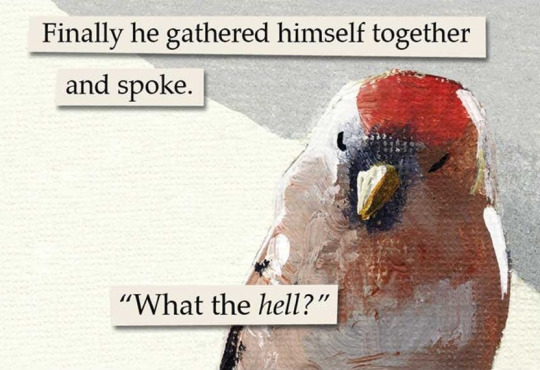
Maximilian I of Austria

James IV of Scotland

Henry VII of England

The Spanish Monarchs

Ludovico Sforza (il Moro), Duke of Milan
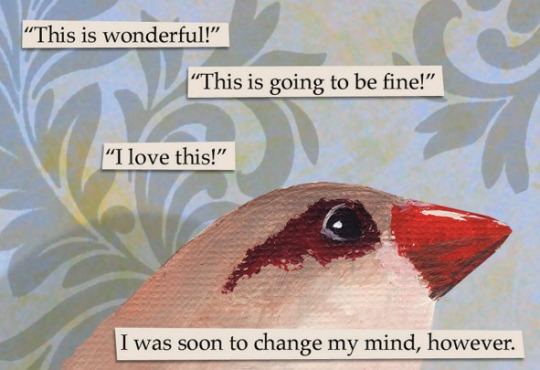
#again:#TOO NICHE i know;;;;;#niche content from yours truly#henry vii#charles viii#maximilian i#james iv#ferdinand of aragon#isabella of castile
32 notes
·
View notes